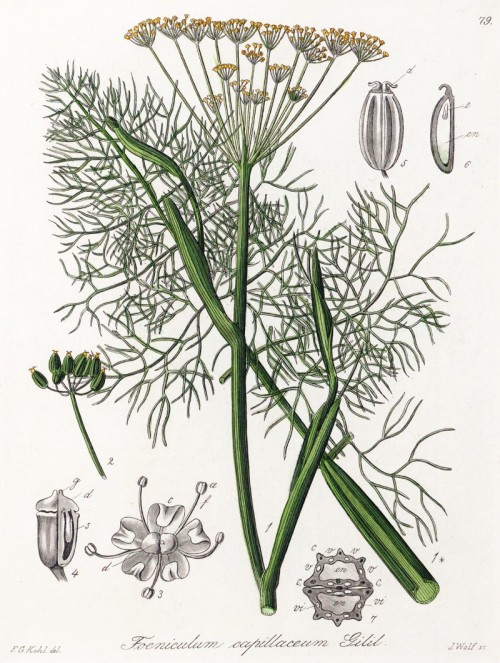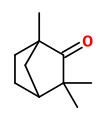Dies ist eine alte Version des Dokuments!
Foeniculum vulgare Mill. - Apiaceae - fennel, (Gewöhnlicher) Fenchel
Perennial herb, indigenous to the shores of the Mediterranean; naturalized and cultivated in many parts of the world.
„Fennel is widely cultivated, both in its native range and elsewhere, for its edible, strongly flavoured leaves and fruits… The Florence fennel (Foeniculum vulgare Azoricum Group; syn. F. vulgare var. azoricum) is a cultivar group with inflated leaf bases which form a bulb-like structure…“
„Fennel is widely employed as a carminative, both in humans and in veterinary medicine (e.g., dogs), to treat flatulence by encouraging the expulsion of intestinal gas.“
http://en.wikipedia.org/wiki/Foeniculum_vulgare
There are some subspecies/varieties :
Foeniculum vulgare Mill. subsp. vulgare var. vulgare - wild fennel, bitter fennel, Wilder Fenchel
Foeniculum vulgare Mill. subsp. vulgare var. azoricum (Mill.) Thell., bulb fennel, Florence fennel, Gemüsefenchel
Foeniculum vulgare Mill. subsp. vulgare var. dulce (Mill.) Batt. - sweet fennel, Süßfenchel
Foeniculum vulgare Mill. subsp. piperitum (Ucria) Cout. - bitter fennel, Bitterer Fenchel
http://www.ars-grin.gov/cgi-bin/npgs/html/taxon.pl?300219
„Florence fennel plants are smaller than the wild type. Their inflated leaf bases are eaten as a vegetable, both raw and cooked. There are several cultivars of Florence fennel, which is also known by several other names, notably the Italian name finocchio.“
http://en.wikipedia.org/wiki/Fennel
Steam distilled essential oil of Foeniculum vulgare Mill. ssp. capillaceum (Gilib.) Holmboe var. dulce Mill.; sweet fennel seeds of greek origin contained (E)-anethole (86-92%) as main constituent, furthermore estragole (3-4%), limonene (1-4%), fenchone (1-2%), p-anisaldehyde (1%).
[Study of different parameters influencing the composition of hydrodistilled sweet fennel oil. Katsiotis, Stavros T., Flavour and fragrance journal 4.4 (1989): 221-224] http://www.pharm.auth.gr/katsiotis/pdfs/7i.pdf
Enantiomerically pure (+)-fenchone was detected in the essential oils of wild, bitter and sweet fennel plants and seeds.
[Chiral GC analysis of enantiomerically pure fenchone in essential oils., Ravid, U., Putievsky, E., Katzir, I., Ikan, R., Flavour and fragrance journal, 7(3), 1992, 169-172]
„A comparison study of 13 fennel (Foeniculum vulgare Mill. var. vulgare) populations of different origins were carried out on the basis of morphological and chemical characters. Relatively stable and variable characteristics were distinguished from evaluating the correlation matrix of the morphological and chemical properties from two successive years… for essential oil accumulation, the presence of (E)-anethole and methyl chavicol were stable characteristics (r=0.923, 0.876). Three distinct intraspecific chemical taxa could be separated based on the cluster analysis of the seed oil: fenchone-rich (31-42% fenchone), methyl chavicol-rich (30-43% methyl chavicol) and (E)-anethole-rich (60-85% anethole) chemovarieties.“
[Morphological and Chemical Evaluation of Fennel (Foeniculum vulgare Mill.) Populations of Different Origin, J. Bernáth , É. Németh , A. Kattaa and É. Héthelyi, Journal of Essential Oil Research
Vol.8 (3),1996, 247-253]
„The chemical composition of the volatile oils of seeds of Foeniculum vulgare Miller from two Spanish locations (Santander and Aranjuez) were investigated by means of GC and GC/MS. Leaf and stem oils of F.vulgare from Aranjuez were also examined. Two different chemotypes have been found in the seeds: (I) methyl chavicol (54.9%), fenchone (24.6%) in the seeds collected in Santander; and (II) (E)-anethole (54.9-38.1%), fenchone (22.2-34.4%) in the seeds gathered in Aranjuez. The oil from the leaves collected in Aranjuez (April, June) was found to contain methyl chavicol (12.3-12.1%), α-phellandrene (9.4-27.2%), limonene (25.3-18%) and fenchone (19.4-18.3%) as major constituents. The oil from the stems gathered in Aranjuez (September) was characterized by a high content of (E)-anethole (17.4-33%), α-pinene (9.7-14.4%), α-phellandrene (24.3-31.4%), p-cymene (11.5-5.2%), limonene (11.6-15%) and fenchone (9.1-17.5%).“
[Chemical Composition of Fennel Oil, Foeniculum vulgare Miller, from Spain. Noemí García-Jiménez, María José Péerez-Alonso, Arturo Velasco-Negueruel, Journal of Essential Oil Research, Vol. 12 (2) 2000, 159-162]
„In order to develop an ideal drug against arteriosclerosis, we tried to find anti-platelet aggregation factors in fennel oil among conventional essential oils: the reason for the investigation was that anethole, the main constituent of fennel oil, resembled eugenol, which was described as having both anti-bacterial and anti-platelet activities. Fennel oil, its constituents and related compounds were examined to find those that would inhibit aggregation of rabbit platelets induced by ADP, collagen or arachidonic acid. Fennel oil, anethole and estragole were proved to be good inhibitors, as effective as aspirin, against platelet aggregation with three types of inducers while p-anisidine was effective on two types. Judging from these experiments and review, we concluded that anethole was the main inhibitor in the fennel oil against platelet aggregation.“
[Aromatic factors of anti-platelet aggregation in fennel oil., Yoshioka, M., Tamada, T., Biogenic amines, Vol.19(2), 2005, 89-96]
„Volatile oil extracts of fennel seeds (Foeniculum vulgare Mill.) and thyme leaves (Thymus vulgaris L.) were obtained by simultaneous distillation-extraction (SDE) and supercritical fluid extraction (SFE) and analyzed by gas chromatography-mass spectrometry (GC-MS). In general, fennel oil extracted by SDE and SFE showed similar compositions, with trans-anethole, estragole, and fenchone as the main components… Key odorants of fennel seeds determined by gas chromatography-olfactometry (GC-O) showed similar patterns when applying SDE and SFE. trans-Anethole (anise, licorice), estragole (anise, licorice, sweet), fenchone (mint, camphor, warm), and 1-octen-3-ol (mushroom) were the most intense odor compounds detected in fennel extracts.“
[Volatile components and key odorants of fennel (Foeniculum vulgare Mill.) and thyme (Thymus vulgaris L.) oil extracts obtained by simultaneous distillation-extraction and supercritical fluid extraction. Díaz-Maroto, M. C., Díaz-Maroto Hidalgo, I. J., Sánchez-Palomo, E., Perez-Coello, M. S., Journal of agricultural and food chemistry, Vol.53(13), 2005, 5385-5389]
„The flavor of fennel fruits and fennel tea was examined by aroma extract dilution analysis of the respective dichloromethane extracts. In both fennel fruits and tea, trans-anethole, anisaldehyde, and trans-4,5-epoxy-2(E)-decenal showed high flavor dilution (FD) factors followed by fenchone, 1,8-cineole, (R)-α-pinene, estragole, and β-myrcene. On the basis of these results, the odorants showing higher FD factors were quantified in tea as well as in fruits, and odor activity values (OAV) in tea were calculated by dividing the concentration of the compound by its recognition threshold in water. The highest OAV was found for trans-anethole, followed by estragole, fenchone, 1,8-cineole, (R)-α-pinene, β-myrcene, and anisaldehyde. From a comparison of the concentrations of odorants in fruits and tea, trans-anethole and estragole showed similar extraction rates of approximately 10-15%, whereas the extraction rates for (R)-α-pinene, β-myrcene, and limonene were below 2%. In contrast to this, fenchone, camphor, linalool, and carvone showed higher extraction rates (26-50%), whereas the high apparent extraction rates of anisalcohol (393%) and vanilline (480%) were attributed to the formation from precursors. Sensory studies of aqueous models containing odorants in the amounts quantified in fennel teas revealed high similarity of the models with the tea and proved that all impact odorants had been identified in their correct concentrations. Further sensory experiments showed that estragole had no odor impact on the overall flavor of fennel tea, and, therefore, a reduction of estragole in fennel products would have no negative impact on their sensoric quality. In contrast to this, trans-anethole and fenchone were found to be character impact compounds of fennel.“
[Character impact odorants of fennel fruits and fennel tea., Zeller, A., Rychlik, M., Journal of agricultural and food chemistry, Vol.54(10), 2006, 3686-3692]
Four different fruit oils are described:
(1) Bitter fennel oil (ssp.vulgare var.vulgare): (E)-anethole 50-75%, fenchone 12-33% (tasting bitter!), estragole 2-5%
(2) Sweet fennel oil (ssp.vulgare var.dulce): (E)-anethole 80-90% (or more), fenchone 1-10%, estragole 3-10%
(3) Anethole-free oil (ssp.vulgare var.vulgare): fenchone 10-30%, estragole 50-80%
(4) Australian wild fennel oil: (E)-anethole 10-20%, fenchone 10-20%, estragole 50-65%
[Hagers Handbuch der Pharmazeutischen Praxis, Springer 2010]

Foeniculum vulgare Mill. as Foeniculum capillaceum Gilib.
Kohl,F.G., Die officinellen Pflanzen der Pharmacopoea Germanica, t.79 (1891-1895) [F.G.Kohl]
http://plantgenera.org/species.php?id_species=442536



